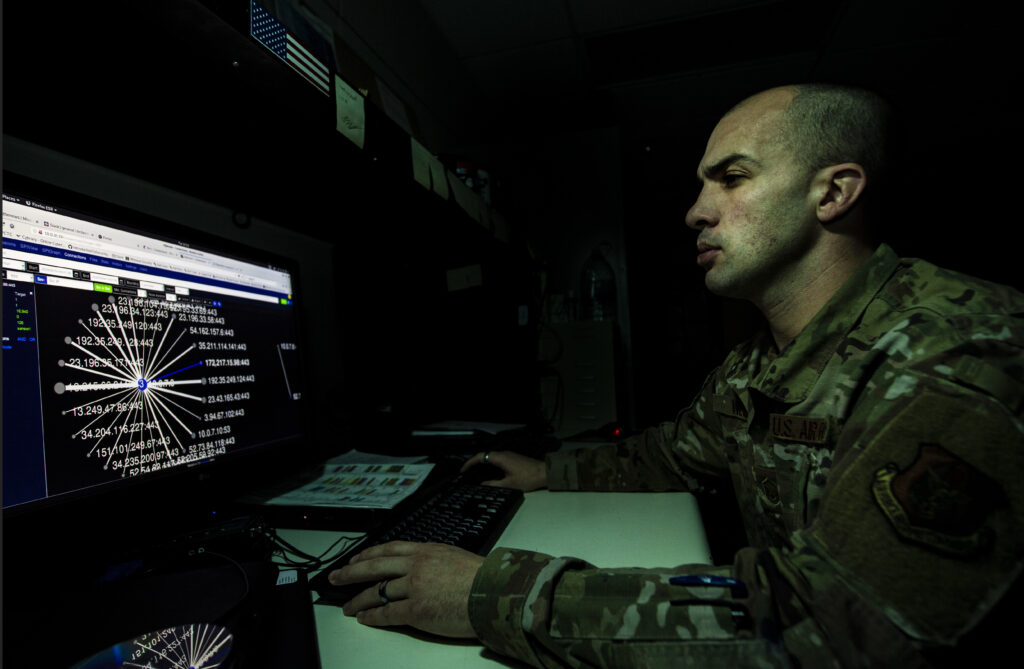By KELSEY ATHERTON

Transforming data from abstract, machine specific outputs to useful, shareable, information across machines is a goal of the new Defense Department Data Strategy.
ALBUQUERQUE: The new Department of Defense Data Strategy is designed to flatten the obstacles — technical and cultural — that prevent easy data sharing across the military services to enable the Pentagon’s push towards Joint All-Domain Command and Control (JADC2). Getting the right data, into the right hands, in a timely and useful manner, without any questions about the data’s integrity, is essential.
“The responsibility of all DoD leaders is to treat data as a weapon system and manage, secure, and use data for operational effect,” writes Deputy Defense Secretary David Norquist in the strategy’s foreword.
The military, with its enormous intelligence, surveillance, and reconnaissance apparatus, is already adept at accumulating information, and so the strategy focuses instead on how to convert that already-acquired information into shareable and useful facts.
It means, in particular, giving units access to data without the person holding the data checking first to see if the recipient is entitled to use it.
“I think some of the JADC2 demos have shown us very tangible results here,” said a defense official, noting the March 2020 event at Andrews Air Force Base, “where we saw an Army howitzer, through an Air Force Data Fabric, knock down a cruise missile that was templated to be flying into North America.”
Moving data across different service networks, and pairing Air Force sensor information with Army artillery targeting, is all supported by the strategies call for a “cultural shift from the need to know (i.e., information withholding) to the responsibility to provide (i.e., information sharing).”
To make this meaningful and timely, the process of data sharing, as well as validation, has to be automated, and it is easiest to build that kind of cross-force interoperability into sensors, networks, and data architecture from the start.
“There’s a JADC2 data pipeline,” said a senior defense official. “And it’s our responsibility to collectively ensure that the JADC2 pipelines, discovery, ingestion, preparation, storage and processing, exposing and disseminating are capable of machine to machine interfacing with an automated orchestration capability. That really only only happens if we use an open data standards architecture.”
The strategy offer goalposts to ensure the data is interoperable, not just within the Pentagon but among coalition partners, too. Another objective is to allow public, unclassified, data to be ingested by computers without human intervention. Another is making data interoperable won’t cause a loss of fidelity. For example, a video recorded by a drone can transfer that data to an operator on the ground with the same clarity and accuracy.
In developing the strategy, the office of the Chief Data Officer reached out to industry to align goals, while emphasizing the need for much greater precision because the stakes are literally life and death.
“The level of scrutiny and performance of data analytics, or predictive analytics, or autonomy needs to be much more precise,” than that required of commercial businesses, said the defense official. “We can’t accept a threshold of ‘deploy and learn’ where the bottom line will be we won’t make as much revenue. Ours is necessarily a requirement to be the most precise.”
To get the strategy started, the Chief Data Officer Council will use create a common vocabulary and common metrics for performance. The strategy will also guide requirements and standard-setting going forward. Because adapting legacy systems would be too expensive, the strategy expects most legacy systems to be left out of the new efforts.
If data is to be, as DOD Chief Information Officer Dana Deasy said “the ammunition in the Digital Modernization Strategy,” it needs to be in the hands of the people who can use it, and it needs to work with the machines they already have. The new Data Strategy is an attempt to make data shareable across the force, with greater ease and standardization than already exists for bullets.
No comments:
Post a Comment